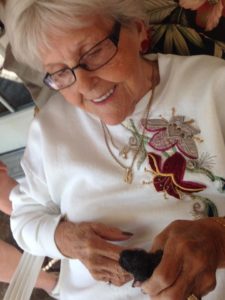My grandmother, born in October 1928, grew up on her grandparent’s farm in Craigsville, West Virginia. Her childhood began alongside The Great Depression. As one of the middle children, she had many responsibilities around the farm. Some of her earliest memories are of the animals on the farm, especially the chickens.
My grandmother has loved chickens from an early age; she raised her own on numerous occasions throughout her life. When I received my first chicks, she was so excited to pass her knowledge and amazing stories. I decided to write about one of my favorites. To be totally honest I thought it to be more of a fable, but after some research, I realized just how wrong I was.

My amazing Grandma
As a young girl, grandma had many hens to tend to. One stood out above the rest: Penny. She slowly began to change, unlike the others, going from a docile little hen to a mysteriously bizarre hen, and one day, she began to crow. Taken off guard, my grandma simply dismissed the action, believing she must have been hearing things. Over time Penny began to take on a very different look: long tail feathers and saddle feathers began to grow. Her comb enlarged, her body thickened and grew. Spurs were slowly growing longer and longer as days turned into weeks. This was no young spry chick, but a full-grown laying hen, who had been laying for some time now. So how was it possible for Penny to change so much so rapidly? The answer is complicated.
You must first understand the chicken’s reproductive make up. All chickens are born with a left ovary and a gonad on the right of their reproductive tract. In very rare cases, the ovary becomes damaged, and the estrogen levels begin to drop. In return, the testosterone levels begin to rise, and it triggers the dormant gonad to begin working. Then, the dormant gonad is activated, thus developing into the male sex organ called an ovotestis. Testosterone begins to fill the body, replacing the estrogen, and the hen begins to take on a rooster’s physical traits as well as their personality traits.
Transitioning during “Henopause” is also a possibility. With the same theory in place, estrogen levels lower and testosterone begins to rise. Even rarer are cases of roosters becoming hens. Either way, spontaneous sex reversal is extremely rare. I could find no evidence whether or not reproduction is possible after sex reversal takes place.

To this?

Can a hen go from this?
So, fable or truth? With documented cases being so hard to come by, I suppose we may never know for sure. My grandmother was given an amazing opportunity to witness such a phenomenon. Maybe, just maybe, that poor hen thought if she turned into a rooster she could help populate their flock, and thus help to fight starvation and protect the little girl who took such exceptional care of her.
The Great Depression produced a whole generation of forward thinkers. Penny may just have been one of them. As for my grandma, now eighty-nine years old, she still stands by her story. And I, for one, tend to believe every word. So, a crowing hen? I’m inclined to say yes.
Plus, how could anyone doubt my amazing grandma?













3 Comments
I currently have a barred rock hen who recently started crowing. She is about three years old.
I found this article while researching why my hen stopped laying, became aggressive with the other hens and is now crowing in the mornings! Her name was Barbara; now we’re using the name Bob. Apparently this is winning-the-lottery rare, but rather than millions of dollars, we have a mean chicken.
Hi Daniel,
You sure have won the lottery! An awesome thing for you to get to witness in real life. I hope the aggression issues faze out as she becomes more comfortable in her new skin.
-Carrie